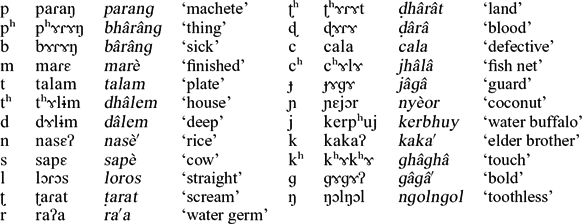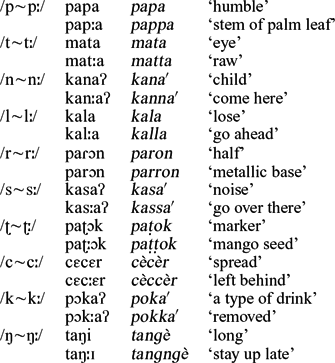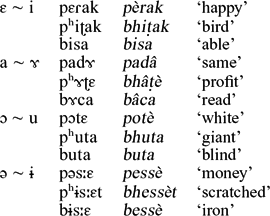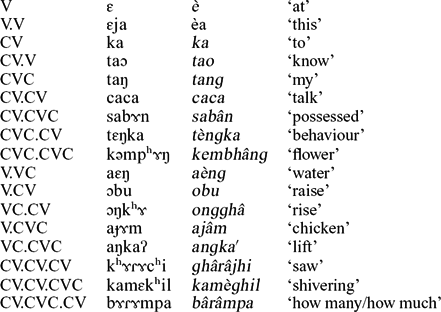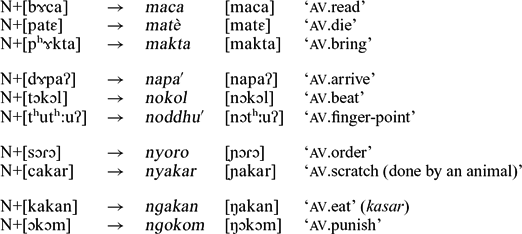Madurese (bhâsa Madhurâ) is a Malayo-Polynesian language spoken primarily on the island of Madura and a number of regions in East Java, Indonesia. Its further subgrouping has remained a matter of some dispute. Early work placed Madurese in a Malayo-Javanic subgroup containing Javanese, Sundanese, and Malay (Dyen Reference Dyen1963). Glottolog and Ethnologue use the more recent ‘Malayo-Sumbawan’ classification (Adelaar Reference Adelaar2005a), which puts Malayic, Chamic, and the Balinese-Sasak-Sumbawa group into one branch with Madurese and Sundanese in two other branches, to the exclusion of Javanese. Robert Blust, rejecting the Malayo-Sumbawan hypothesis, tentatively places Madurese in a Malayo-Chamic subgroup (Blust Reference Blust2009), but also suggests (Blust Reference Blust2010) that, as Madurese is lexically similar to Malay but phonologically and morphologically quite different, it may once have subgrouped with Javanese and later underwent heavy relexicalization due to language contact (see also discussion in Kluge Reference Kluge2017: 3).
The number of Madurese speakers who speak the language for daily communication at home is approximately 7.8 million (Ananta et al. Reference Ananta, Arifin, Hasbullah, Handayani and Pramono2015: 278). This number includes both speakers living on the island of Madura itself as well as those living on other islands across the Indonesian archipelago (see Figure 1). Outside Madura, speakers of Madurese are mostly concentrated in a number of regencies across the north coast of East Java. On the island, Madurese is formally taught in schools from grade 1 to grade 11 as part of muatan lokal (local content), but most speakers are also fluent in Indonesian.

Figure 1 Map of the island of Madura and location in the Indonesian archipelago (inset). The boundaries of the Bangkalan, Sampang, Pamekasan and Sumenep regencies are indicated by grey lines.
Madurese uses the Roman script for its writing system. The orthography has been revised on a number of occasions (see Davies Reference Davies2010: 51–60 for a review); in this Illustration, we use the 2008 Balai Bahasa Surabaya system adopted in some recent dictionaries (e.g. Pawitra Reference Pawitra2009). In the pre-colonial period, Madurese was written using a syllabary originating from the Javanese script called aksara Jhâbân, which literally means ‘the Javanese letters’. This system originally derives from the Grantha- or Palava-script of South India, which also has an indirect relation to the Devanagari script of North India (Adelaar Reference Adelaar, Adelaar and Himmelmann2005b: 3–4). Although the aksara Jhâbân is no longer in use, it remains formally taught in schools along with the language.
Like Sundanese, Javanese, and some other languages of the region, Madurese maintains an elaborate system of lexical variants based on the social relationship between speaker and addressee, commonly known as ‘speech levels’. The alus ‘refined’ vocabulary is primarily borrowed from Javanese, while the kasar ‘rough’ substrate shows greater similarities with Malay (Stevens Reference Stevens1968). For overviews, references, and comparisons to related systems see Stevens (Reference Stevens1965) and Davies (Reference Davies2010).
Madurese distinguishes three main dialects: Western Madurese, spoken in Bangkalan Regency; Central Madurese, spoken in Pamekasan and Sampang Regencies; and Eastern Madurese, spoken in Sumenep Regency. However, the isoglosses defining the dialect areas do not line up perfectly with the administrative regions, or with each other. In Sampang Regency for example, there are areas which are characterized by more Western/Bangkalan features, and others by more Central/Pamekasan features, and in one and the same village there is often a mix of both (Soegianto et al. Reference Soegianto and Soetarto1986, Soetoko et al. Reference Soetoko and Surani1998). Soegianto et al. (Reference Soegianto and Soetarto1986: 32) also note that increased mobility has resulted in extensive dialect mixing, making it difficult to unambiguously identify a speaker's dialect.
The most visible differences between dialects are in the domains of morphology, lexicon, and to some extent syntax (Kiliaan Reference Kiliaan1897a, Reference Kiliaanb; Soegianto et al. Reference Soegianto and Soetarto1986; Soetoko et al. Reference Soetoko and Surani1998; Davies Reference Davies2010). In terms of phonetic and phonological variation, we note a tendency for word-final vowels to be lengthened in Eastern Madurese, and for phrase-final open syllables to be realized with final [h] in the Central and Western dialects, a point we return to below. Soegianto et al. (Reference Soegianto and Soetarto1986) mention possible dialect differences in intonation, as well as in patterns of vowel reduction and elision, but do not indicate them in their survey; these are clearly areas that invite further study. In addition, the varieties of Madurese spoken on East Java, as well as the closely related language of the Kangean islands, have not to our knowledge been carefully described.
Eastern Madurese, as spoken in and around Sumenep Regency, is regarded as the prestige dialect, and this is what is taught in schools. The dialect described in this illustration more closely reflects the features of Central Madurese, as spoken by the first author, who was born in 1975 in Pademawu district, Pamekasan and now lives in Bangkalan. The associated audio files were produced by the first author and they became the main data set on which the current analysis is based. The data used for Figure 5 below was taken from the first author's dissertation (Misnadin 2016).
Consonants
Compared to its neighbouring languages such as Javanese, Sundanese, or Indonesian, Madurese has a relatively large consonant inventory, due primarily to the large number of distinctions between plosives. The native phonemes are illustrated in the following words:
(1)

Word-medially, almost all consonants can also occur as geminates, due either to an underlying contrast or allophonic or morphophonemic conditioning. Examples are given in (4) and (16) below.
In native vocabulary, /ʔ hjw/ do not occur word-initially, and in word-medial position /ʔ/ can only function as a syllable coda. Only /ptkmn ŋ lrsj ʔ/ occur word-finally. For more on /h/, see section ‘“Marginal” and non-native segments’ below.
Place of articulation
Madurese distinguishes five places of articulation in the plosive series and four places of articulation in the nasal series. While previous researchers agree that there are five places of articulation in Madurese, there is some variation in the way they are labelled. Stevens (Reference Stevens1968, Reference Stevens, Adams and Hudak1994) names them as labial, dental, alveolar, palatal and velar, noting that while the alveolar series might be treated as retroflex for the purposes of a distinctive feature analysis, ‘this is neither phonetically accurate, nor could this feature be used elsewhere in the language’ (Reference Stevens1968: 66). Cohn & Ham (Reference Cohn, Ham, Zeitoun and Li1999) add retroflex but they do not distinguish retroflex from alveolar, labelling them labial, dental, retroflex/alveolar, palatal and velar. In contrast, Davies (Reference Davies2010: 12) does not make a distinction between dental and alveolar, but instead distinguishes dental/alveolar from retroflex, as does Kiliaan (Reference Kiliaan1897a). Clynes (Reference Clynes and Tryon1995) suggests that the ‘retroflex’ consonants are better described as apico-alveolar, and that the coronal place contrast in both Madurese and Javanese is actually apico-dental vs. apico-alveolar.
In the speech of the first author, the coronal plosives /t tʰ d/ are canonically laminal denti-alveolar [t̪ t̪ʰ d̪], while /nslr/ are apico-alveolar [n̺ s̺ l̺ r̺]. In citation forms, the retroflex plosives are apical or subapical post-alveolar, with a moderately concave tongue body. However, these can and do surface as apico-alveolar as well, especially /ɖ/. While retroflex plosives sometimes surface as alveolars, the converse does not occur (i.e. /t tʰ dnlsr/ do not have retroflex variants). Whether different speakers primarily opt for one or the other, or whether there are variants that occur systematically in different lexemesFootnote 1 or different connected speech contexts, is at present unclear. The fact that virtually all Madurese also speak Indonesian may play a role. In any case, it seems likely that this variability has led to the range of variation in published descriptions.
Although dental and retroflex are contrastive in the speech of the first author, the functional load of this contrast is not very high. This is evidenced by there being very few minimal pairs contingent on this distinction, for example [patɛ] ‘death’ vs. [paʈɛ] ‘coconut milk’, [tʰɤntʰɤn] ‘dress up’ vs. [ʈʰɤnʈʰɤn] ‘snatch’.
Laryngeal contrast
Acoustically, Madurese distinguishes voiced, voiceless unaspirated, and voiceless aspirated plosives (except word-finally, where all oral plosives are voiceless unaspirated and canonically unreleased). This is unusual when compared to geographically and genetically neighbouring languages, which uniformly have a two-way contrast between either unaspirated and prevoiced plosives, as in Indonesian (Adisasmito-Smith Reference Adisasmito-Smith2004) and Sundanese (Kulikov Reference Kulikov2010), or ‘stiff voice’ vs. ‘slack voice’, as in Javanese (Ladefoged & Maddieson Reference Ladefoged and Maddieson1996, Thurgood Reference Thurgood2004). As shown in Figures 2 and 3, voiced plosives in Madurese are robustly prevoiced in both absolute initial and medial position. Although statistically significant, the difference in VOT values between voiceless aspirated and unaspirated plosives is on the order of 2:1 (Cohn & Lockwood Reference Cohn and Lockwood1994, Misnadin, Kirby & Remijsen Reference Misnadin and Remijsen2015, Misnadin 2016) in contrast to the 3:1 or 4:1 difference often observed between these plosive series in other languages (Lisker & Abramson Reference Lisker and Abramson1964). Orthography, historical evidence (Stevens Reference Stevens1966), and early descriptions (Kiliaan Reference Kiliaan1897a) all suggest that the aspirated series was previously voiced. However, acoustic analyses of the modern language have found no evidence that aspirated plosives ever involve vocal fold vibration during the closure phase (Cohn & Ham Reference Cohn, Ham, Zeitoun and Li1999, Misnadin 2016).

Figure 2 Spectrographs of (a) voiceless unaspirated [p] in [paɾaŋ] ‘machete’, (b) aspirated [pʰ] in [pʰɤɾɤŋ] ‘thing’, and (c) prevoiced [b] in [bɤɾɤŋ] ‘sick’. VOT is about 10 ms for [p] and 55 ms for [pʰ].

Figure 3 Spectrographs of (a) voiceless unaspirated [k] in [kakaʔ] ‘elder brother’, (b) aspirated [kʰ] in [kʰɤkʰɤ] ‘touch’, and (c) prevoiced [ɡ] in [ɡɤɡɤʔ] ‘bold’ in both initial and medial positions. VOT is about 25 ms for [k] and 55 ms for [kʰ].
Despite the phonetic evidence to support a three-way contrast, minimal triplets distinguishing aspirated, unaspirated, and voiced plosives do not exist. We can only find binary minimal sets distinguishing voiceless aspirated and voiced plosives, for example [bɤɾɤ] ‘swollen’ vs. [pʰɤɾɤ] ‘lung’, [bɤlɤ] ‘tell’ vs. [pʰɤlɤ] ‘family’ or [raɟɤ] ‘big’ vs. [racʰɤ] ‘steal by magic power’. This is because the vowels following voiceless aspirated and voiced plosives are in complementary distribution with those following voiceless unaspirated plosives: voiceless aspirated and voiced plosives are followed by high vowels, while voiceless unaspirated plosives are followed by non-high vowels. Some examples are given in (8) below.
Although the VOT difference is marginal and the contrast is probably borne primarily by the vowel height differences, it is worth noting that the VOT distributions themselves appear to be quite stable (Misnadin 2016).
Approximants
In native vocabulary, the approximant /j/ only occurs in word-final position, e.g. [kərpʰuj] ‘water buffalo’, [apɔj] ‘fire’, [sɔɾɔj] ‘comb’. One argument for claiming that it is phonemic in this position is that it becomes a syllable onset when certain affixes are added. When words ending with /j/ are followed by the definite suffix -na, for example, the suffix appears in its -a allomorph, e.g. [kərpʰujɤ] ‘his/her water buffalo’, [apɔja] ‘his/her fire’, [sɔɾɔja] ‘his/her comb’, cf. [sɔɾɔ] ‘order’, [sɔɾɔna] ‘his/her order’, [pɔɾɔ] ‘ulcer’, [pɔɾɔna] ‘his/her ulcer’. In contrast, /w/ never occurs in word-final position.
Intervocalically, /w/ and /j/ appear due to an insertion process triggered when two vowels differing in backness occur next to one another. The first vowel determines which approximant to be inserted: [j] is inserted after a front vowel whereas [w] is inserted after a back vowel. However, insertion does not take place if the vowel sequence rises in height (see the ‘Vowel hiatus’ section, below). Word-internally, the occurrence of approximants is thus completely predictable. Examples of word-internal approximants are shown in (2), with examples involving affixation given in (3).
(2)
Footnote 2
(3)

Word-initially, /jw/ occur only in loanwords, although many of these items are now well-integrated into the lexicon. For further details see section ‘“Marginal” and non-native segments’, below.
Rhotics
Word-initially and word-finally, /r/ is typically realized as a trill [r] as in [rɔwa] ‘that’, [ɲakar] ‘scratch (done by an animal)’, [lapar] ‘hungry’. /r/ may also surface as an approximant [ɹ] as in [ɹakət] ‘close’, [ɹas:a] ‘taste’.
Word-medially, /r/ is often a tap, for example [bɤɾɤŋ] ‘sick’, [lɔɾɔs] ‘straight’, [maɾɛh] ‘finished’. This is because its geminate counterpart (which can only occur word-medially) is realised as a trill [r], for example [kʰɨrɤ] ‘hard’, [mərəs] ‘squeeze’, [parɔn] ‘metallic base’; see Cohn & Ham (Reference Cohn, Ham, Zeitoun and Li1999) and the examples in (4) below. Note that singleton /r/ may also be realized as a trill word-medially, as in [kerpʰuj] ‘water buffalo’. Cohn & Ham (Reference Cohn, Ham, Zeitoun and Li1999) describe the geminate trill as longer than the singleton, but we do not observe a difference in our data, with the trill in both cases exhibiting from two to four taps.
Geminates
All of the consonants in (1) above can also appear as word-medial geminates. Geminates occur both as the result of an underlying contrast, as illustrated in (4), or due to allophonic and morphological conditioning, as in the examples in (16).
(4)
Footnote 3
Acoustic analysis of the items in (4) shows that closure durations for geminates are on average 50% longer than those of corresponding singletons (range: 30–90%), while vowels preceding geminates were on average 55% shorter than those preceding singletons (range: 51–60%). No difference in the duration of the following vowel is observed, nor does VOT differ between singleton and geminate plosives. These observations correspond to those of Cohn & Ham (Reference Cohn, Ham, Zeitoun and Li1999).
‘Marginal’ and non-native segments
The segments /fwjh/ require special mention. Word-initially, they are found only in loanwords. Those beginning with /f/ and /h/ may have been borrowed from Arabic, Indonesian or Malay while those beginning with /wj/ may have been borrowed from Arabic or Malay (Stevens Reference Stevens1968). Some examples are given in (5). Note that in general, Indonesian and Javanese cognate forms with initial /w/ will have /b/ in Madurese (Kiliaan Reference Kiliaan1897a, Stevens Reference Stevens1966).
(5)

As noted above, /j/ differs from /w/ in that /j/ occurs word-finally in native vocabulary, and is treated phonologically as a consonant in this environment. However, both /j/ and /w/ are clearly visible to the phonology, as they are both copied in reduplication (see Cohn Reference Cohn1993b: 356–360). Thus, they are ‘marginal’ only in the sense that they do not occur word-initially in native vocabulary, but are otherwise treated like other native segments.
It has previously been noted that an optional final [h] may be pronounced in phrase-final words ending with vowels, at least in western varieties of Madurese (Kiliaan Reference Kiliaan1897a: 5; Pawitra Reference Pawitra2009; Davies Reference Davies2010: 26–27). However, there do exist a number of minimal pairs nominally distinguished by presence vs. absence of final [h]. Some examples are given in (6).
(6)

The difference is subtle but audible, and clearly visible in the acoustic signal (Figure 4).
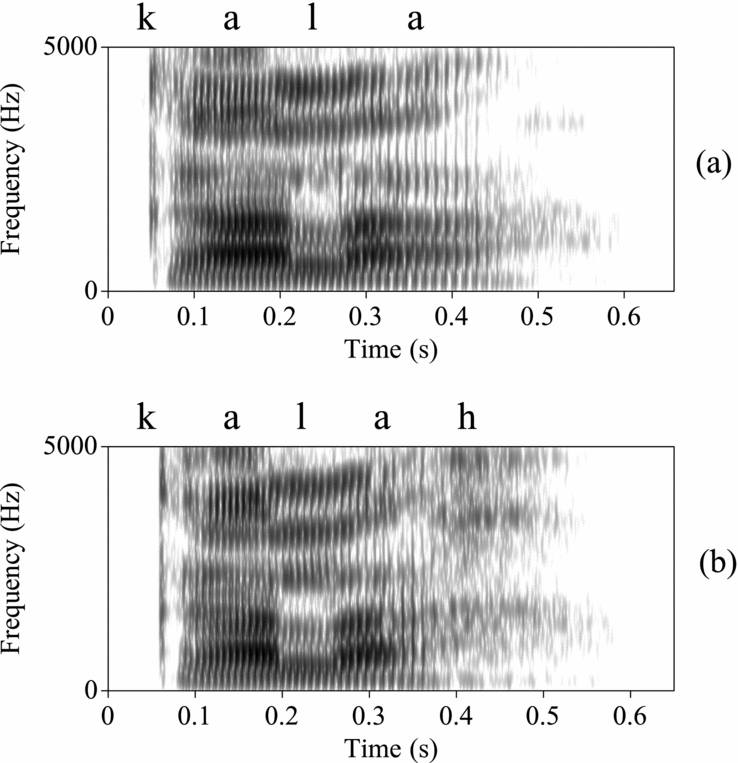
Figure 4 Spectrographs of (a) /kala/ ‘lose’ and (b) /kalah/ ‘scorpion’.
While the durations of both items are extremely similar, in careful pronunciations of items like /kalah/ ‘scorpion’, the second vowel is considerably shorter and followed by a period of glottal frication. The frication of this ‘lexical’ /h/ is much stronger than of the ‘optional’ [h]. However, in Eastern Madurese the pairs in (6) are homophones, and a distinction is often not made in the Western and Central varieties either. Moreover, lexical /h/ is inconsistently indicated in the orthography, with items like /kalah/ variably spelled as kala or kalah (Pawitra Reference Pawitra2009). In the absence of clear acoustic evidence such as that seen in Figure 4, we have left possible instances of final [h] in this Illustration untranscribed.
Vowels
Monophthongs
Madurese has eight phonetic vowel qualities: four high vowels [i ɨ ɤ u] and four non-high vowels [ɛ ə a ɔ].
(7)

The high vowels have a restricted distribution, occurring only after voiced and voiceless aspirated plosives, while non-high vowels occur elsewhere. The eight phonetic vowel qualities can thus be described in terms of four high-low pairs. This consonant–vowel (CV) co-occurrence restriction was first described by Kiliaan (Reference Kiliaan1897a) and discussed by a number of authors including Stevens (Reference Stevens1968, Reference Stevens, Aronoff and Kean1980, Reference Stevens, Adams and Hudak1994), Trigo (Reference Trigo1991), Anderson (Reference Anderson, Ann and Yoshimura1991), Cohn (Reference Cohn and Beals1993a, Reference Cohn, Edmondson and Gregersonc), Cohn & Lockwood (Reference Cohn and Lockwood1994) and Cohn & Ham (Reference Cohn, Ham, Zeitoun and Li1999). Some examples illustrating the CV co-occurrence restriction involving the alternations of non-high and high vowels are given in (8).
(8)

Figure 5 shows an F1/F2 vowel plot for the surface vowels with z-normalisation. The plot is based on V1 in recordings of 188 C1V1C2V2(C3) words, read three times in random order by 15 native speakers of Madurese (data from Misnadin 2016). The plot also shows that vowels [ə] and [ɤ] in particular, which do not form a pair, overlap considerably. However, since they phonologically always occur after different consonant types, the systemic stability of eight vowel qualities is maintained.

Figure 5 F1~F2 plot of Madurese vowels with z-normalisation. The ellipses indicate one standard deviation from the mean. Data from Misnadin (2016).
Vowel hiatus
Madurese also has what Tabain & Jukes (Reference Tabain and Jukes2016) term ‘intra-morphemic’ vowel sequences, i.e. sequences of two vowels, each of which heads its own syllable. The vowel hiatus can also occur without an onset consonant. Like Davies (Reference Davies2010: 28), we identify four surface ‘vowel clusters’ [aɛ], [aɔ], [ɤi] and [ɤu]; note that in all four sequences the second vowel is higher than the first. Impressionistically, the first vowel in each cluster bears stress and is longer. Some examples are given in (9).
(9)

That the vowel clusters are really a sequence of two monophthongs, rather than a diphthong, is supported by spectrographic evidence. As seen in Figure 6, these sequences are characterized by two clear periods of steady-state formants, with a rapid transition period between them.

Figure 6 Example of vowel hiatus in [kaɛʔ] ‘hook’.
Phonotactics and syllable structure
Most roots in Madurese consist of two syllables, with CV and CVC being the most common structures (Stevens Reference Stevens1968: 51–52; Davies Reference Davies2010: 25). In terms of word categories, the majority of content words are disyllabic. Monosyllabic words are mostly limited to function words and are associated with borrowings. Some possible syllable structures for monosyllabic, disyllabic and trisyllabic words are given in (10).
(10)

CCV(C) syllables, while rare, are also possible. /Cr/ and /Cl/ onset clusters occur infrequently in some loanwords, e.g. /tarompɛt/ → [trom.pɛt] ‘trumpet’. Theseonsetclustersmayalsoarise, primarilyin Westernand Central Madurese, throughreductionandelisionoftheinitialvowel (usually [a]) intrisyllabicwords, e.g. /pa.ra.o/ → [prao] ‘boat’, /ta.rɛ.tan/ → [tɾɛ.tan] ‘sibling’, /sa.la.kʰɤ/ → [slakʰɤ] ‘rake’, /ka.lɛ.bun/ → [klɛbun] ‘village head’ (Kiliaan Reference Kiliaan1897a: 6; Sutoko et al. Reference Sutoko, Surani, Sariono and Suyanto1998; Davies Reference Davies2010: 42, 44–45).
Vowel height alternations
As discussed above, Madurese vowels can be divided into two sets of high and non-high vowels with a predictable distribution. Vowel height alternations can also occur as a result of morphophonological processes as such affixation. An example comes from the process of nasal substitution, involving an underspecified nasal prefix indicating the ‘actor voice’ form of verbs (Cohn Reference Cohn, Edmondson and Gregerson1993c: 110; Stevens Reference Stevens, Adams and Hudak1994: 363; Davies Reference Davies2010: 32). When an underlying voiced or voiceless aspirated plosive is replaced with its homorganic nasal equivalent, the following vowel is realized as a corresponding low vowel. In this case, the N-prefix behaves like a nasal, as shown in (11).
(11)

Vowel harmony
Unless determined by the preceding consonant, vowels in Madurese words are subject to progressive height harmony. Word-medially, the consonants /r/, /l/ and /ʔ/ are always transparent in the sense that the height of the vowels following these consonants is dependent on the quality of the preceding vowel (Stevens Reference Stevens1968, Trigo Reference Trigo1991). That is, if the vowels preceding them are high, the vowels following them are also high, as exemplified in (12).
(12)

On the other hand, if the vowels before /rl ʔ/ are non-high, the vowels following them will be non-high.Footnote 4 Some examples are given in (13).
(13)

One aspect which deserves mention here is the behaviour of /s/. In word-initial position, /s/ behaves in the same manner as voiceless plosives, nasal consonants, and liquids. When /s/ appears in intervocalic position, the height of the following vowel depends on whether /s/ occurs morpheme-internally or at a morpheme boundary (Stevens Reference Stevens1968, Cohn Reference Cohn and Beals1993a). If it occurs morpheme-internally, the following vowel will be non-high regardless of the preceding vowel height, as exemplified in (14).
(14)

However, if /s/ occurs at a morpheme boundary, the vowel following this consonant is determined by the vowel height preceding it, as shown in (15) (note: the suffix -an changes a verb into a noun while the suffix -ɛ changes a verb into an imperative).
(15)

Gemination
Another type of consonant–vowel interaction in Madurese is one in which particular vowels trigger the appearance of certain consonants, rather than the other way around. This type of consonant–vowel interaction involves two vowels, namely [ə] and [ɨ]. Unlike the other vowels, [ə] and [ɨ] trigger gemination of the following consonant when they occur word-medially as V1 in a CV1CV2(C) context. Some examples are shown in (16).
(16)

It is important to note that while consonants following [ə] and [ɨ] are always geminated, gemination does not entail a preceding [ə] or [ɨ]; see examples in (4) above. This process may be due to a syllable weight requirement. Figure 7 compares CVCV [kala] ‘lose’, CVCːV [kalːa] ‘go ahead’, and CəCːV [pəlːɔ] ‘sweat’. In [kala], the VC sequence is approximately 200 ms, with the vowel having a duration of about 140 ms; in [pəlːɔ], the əCː sequence is approximately 170 ms, with the schwa lasting only 35 ms. In contrast, the VCː sequence in [kalːa] lasts 275 ms. Additional examples may be found in Ham (Reference Ham1998) and Cohn & Ham (Reference Cohn, Ham, Zeitoun and Li1999).

Figure 7 Spectrographs comparing (a) CVCV [kala] ‘lose’, (b) CVCːV [kalːa] ‘go ahead’ and (c) CəCːV [pəlːɔ] ‘sweat’.
Word stress
Word stress is an area that has not been systematically studied in Madurese. Impressionistically, word stress in both disyllabic and trisyllabic words occurs on the first syllable, while stress on words with four syllables appears to fall on the antepenultimate syllable. However, there is at present no phonetic evidence of word stress in Madurese, lexical or otherwise. We note that in its close neighbour Indonesian, the existence of word stress has been much debated (van Zanten & van Heuven Reference van Zanten and van Heuven1998, Reference van Zanten and van Heuven2004).
Transcription of the recorded passage
The Madurese word for ‘day, sun’ is arè but its Indonesian cognate matahari (mata ‘eye’, hari ‘day’) is also commonly used. The Madurese pronunciation contains a medial glottal stop, which is predictably epenthesized between identical vowels (see Davies Reference Davies2010: 40–41).
For clarity, we have marked morpheme boundaries with hyphens in the orthographic forms, but these would not normally be so indicated.
Abbreviations

Acknowledgments
We are grateful to Abby Cohn, an anonymous reviewer, and editor Amalia Arvaniti for many helpful comments and suggestions, which have substantially improved this Illustration. We alone remain responsible for any errors of fact or interpretation. This work was funded in part by a grant to the first author from the Ministry of Research, Technology, and Higher Education of the Republic of Indonesia.
Supplementary material
To view supplementary material for this article, please visit https://doi.org/10.1017/S0025100318000257.


